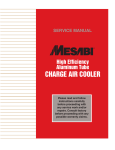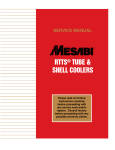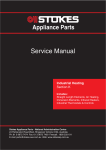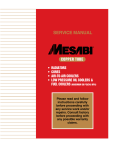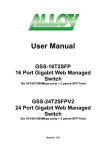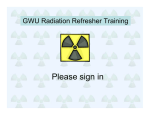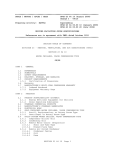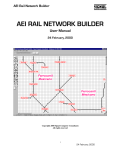Download Charge Air Cooler - L&M Radiator Pty Ltd
Transcript
SERVICE MANUAL High Efficiency Aluminum Tube CHARGE AIR COOLER Please read and follow instructions carefully before installing the MESABI® Charge Air Cooler. Consult factory before proceeding with any possible warranty claims. 2 August 2005 High Efficiency Aluminum Tube Charge Air Cooler CONTENTS Standard Parts ............................................................. Page 3 External Cleaning and Tube Removal .......................... Page 4 Seal Removal & Installation, Header Plate Preparation .............. Page 5 Tube Installation ........................................................... Page 6 Retainer Bar Installation/Final Assembly ..................... Page 7 Testing .......................................................................... Page 7 Manufacturing Facilities and Parts Depot .................... Page 8 Special captured seal offers dependable service The MESABI® Charge Air Cooler (CAC) features a tube-toheader seal that is held captive in the header plate by a special sealing process. The flexible fluorocarbon rubber seals absorb stresses and thermal tube expansion that can cause conventional coolers to fail. The CAC has the following features as well as all the replaceable-tube features of MESABI® heat exchangers. • Field-repairable using simple hand tools. • Lightweight aluminum cooling tubes and frame. • For air-to-air heat exchange. MESABI® Removable Tube Charge Air Cooler MESABI CHARGE AIR COOLER 18 -MONTH WARRANTY ® L&M Radiator warrants the MESABI ® Charge Air Coolers manufactured by L&M for a period of 18 months from date of invoice. Under this warranty, our obligation is limited to the repair or replacement (at our option) of products or parts manufactured by L&M that are proven to be defective in workmanship or material. L&M further warrants the MESABI® Charge Air Coolers against seal leakage during normal use for 18 months from date of invoice on new Charge Air Coolers with MESABI® fluorocarbon seals installed. Damage or leakage due to accidents, misuse, or corrosion is not warranted. Warranty on components not manufactured by L&M Radiator shall be that of the individual manufacturers. Individual manufacturers operational and maintenance requirements must be met and their policies regarding shipment and inspection of claimed defective parts will apply. L&M is not liable for consequential or incidental damages nor their related costs. Consult factory before proceeding with warranty claims. This warranty supersedes all previously published warranties. 3 Standard Parts - MESABI Charge Air Cooler ® 8 1 9 2 10 7 5 3 4 Exploded View – High Efficiency Aluminum Tube Charge Air Cooler 6 12 12 11 1 DESCRIPTION 1. 2. 3. 4. 5. 6. 7. 8. 9. 10. 11. 12. PART NO. Seal ........................................................ 103997 Retainer Bar .............................. refer to parts list Retainer Bolt (5/16” x 21/2”, 18-855) ........ 64801.09 Washer .............................................. 106900.01 O-Ring (SAE 203) .............................. 106902.01 Allen Wrench (3/16” for retainer bolt) ...... standard Retainer Bar (tapped) ................ refer to parts list Inspection Mirror...................................... 104574 Brush ........................................................ 63451 Seal Tool .................................................. 97892 Tube Assembly Tool .............................. 105760 Support Bar .............................. refer to parts list Assembly Lubricant (not shown) ............ 100276 4 REPAIR PROCEDURE External Cleaning and Tube Removal HELPFUL HINTS: • Read this manual thoroughly • Work in a clean environment • Good lighting is a must • Use the proper tools and lubricant • Call L&M Customer Service with questions Fig.1 Removing MESABI® Tubes External Cleaning To maintain efficiency and assure maximum life of a MESABI® Charge Air Cooler, reasonable care must be taken when cleaning. In some cases it may be best to blow out any dry dirt with shop air prior to washing the core with a high pressure hot water wash. If there is any doubt about the cleaning method to be used, try the method on a portion of a single tube first, or contact L&M Customer Service. For general external cleaning, high pressure hot water (with or without soap) can be used at pressures up to 1200 psi. (CAUTION! To prevent fin deformation, stay at least 6” away from the core and you must spray straight into the core – not at an angle. If the cooler is still in the machine, you may have to use an offset angled nozzle so that you can spray straight into the core. If there is any doubt, try your cleaning method on a small portion of the core first.) It is important to start on the air exit side. Work from the top to the bottom. Concentrate on small areas and work slowly. Wash until the water exiting the opposite side is free from dirt and debris. Complete this side and then repeat the process from the other side. Many radiator shops use a hot alkaline soap or caustic soda in their boil-out tanks with chemical additives. Soaking in high pH solutions may damage the aluminum alloy, depending on the exact characteristics of the solution. Solutions that are either too alkaline (pH>9.0) or too acidic (pH<5.0) are not recommended. After a thorough cleaning as described previously, blow the cooler dry, then remove the retainer bar from the top portion of the tube as shown. Use standard 3/16” Allen wrench to remove bolts from retainer bar. Fig.2 Fig.3 Slide the front end of the tube assembly tool between the header plate and the fin on a single tube. Then squeeze the handle together. The tube will become free from the lower seal. With the tube tool still on the tube, pull the tube out of the core as shown in Fig 2. Then remove tool and use hands to pull tube from upper seal as shown in Fig 3. CAUTION: Minimize the removal angle and do not force the tube out. Care must be taken not damage the tube. 5 Seal Removal & Installation - Header Plate Preparation After the tubes are removed, clean the header plate area with a high pressure washer; then blow the inside and outside surfaces of the tanks thoroughly dry with air. ▲ Fig. 4 Insert the pick end of the seal tool under the seal and pull out slightly. CAUTION: Following these steps carefully will help ensure the seals are removed properly, and that the seal groove is not damaged. Fig. 6 Insert a clean brush into the Fig. 5 Insert the seal tool between the seal and groove then remove the seal from the groove. Fig. 7 With a clean brush apply header plate tube hole. Rotate the brush to remove any debris that may be in the groove. Use clean compressed air to blow tanks clean. (Seals that are inadvertently dropped into tank must be removed.) assembly lubricant to the seal groove. Do this by putting lubricant on the brush, and inserting it into the seal groove and use a twisting motion to spread an even coat in groove. (Use a pea sized amount of lubricant per hole.) New Seal Installation Fig. 9 With your finger, push the other end of the seal into the groove while controlling the opposing end with the flat end of the seal tool. Fig. 8 Use the flat hooked end of the ▲ seal tool, pull the seal into an oval shape and insert one end of seal into the seal groove. Fig. 10 Use the back of the seal tool to press the seal firmly into the groove. Fig. 11 To avoid pinching the seal between the tube and groove, a small amount of lubricant may be needed to hold the seal tightly to the long sides of the groove. excess lubricant. NOTE: The seal needs to be completely seated into the groove in order for tube to be installed properly. ▲ Fig.12 Use the brush to smooth any 6 Tube Installation IMPORTANT: Before inserting new or original tubes into the header plates, new seals must be installed and lubricated properly. Fig. 13 Prior to installing tubes, the tube ends must be clean and undamaged. (A cloth buffing wheel can be used) Precaution should be taken when buffing so as not to mar the tube finish. Use a brush and assembly lubricant to apply a thin film on the first 1/4" of tube ends. Fig. 14 At a convenient starting point, push the top end of the tube (end with the longest unfinned section) into the upper header plate seal. Fig. 15 Place the bottom end of the tube into respective seal in the bottom header plate. ▲ CAUTION: Minimize the insertion angle and do not force the tube. Care must be taken not to damage seal or tube. Fig. 16 Push the tube down and into the seal until the fin is located on top of the header plate. This can usually be done by grasping the tube with your hands and pulling downward until seated, or by using the tube assembly tool. CAUTION: Be sure the tube is properly centered in the seal before pushing the tube into place. Fig. 17 Using a light and inspection mirror, inspect each seal after tube insertion. Look for seal protruding into the tank. 7 Retainer Bar Installation/Final Assembly Fig.18 RETAINER BAR SYSTEM. NOTE: Use high temperature anti-seize product on threads Fig.19 Insert the tapped (threaded) retainer bar into the Fig. 20 Insert the front retainer bar, with retainer bolts, Fig. 21 With a 3/16” Allen wrench, tighten bolts to to aid in removal. washers and o-rings through cooler. back side of the cooler. 45 inch pounds of torque. Testing CAUTION: Full face protection must be worn when working on pressurized units. Use only appropriate pressure fittings. Pressure must be applied slowly! Submerge the unit under water prior to applying pressure. Test to 50 psi. During testing, note that bubbles from trapped air in exterior pockets could appear for 10 to 15 minutes (this is normal). Hold the pressure at 50 psi for 15 minutes. Stop the test immediately if any leaks are noted. Repair and test again. We solve big heat transfer problems around the world. Parts shipped within 48 hours from four plants around the world. MESABI ® Radiator Cores, oil coolers and related cooling components are marketed on a factory direct basis from four L&M Radiator plants around the world. L&M Radiator is able to give exceptional service to users and OEMs because all service is controlled at the manufacturer level. In emergencies, we can ship complete radiator cores or parts within 48 hours. On site technical and engineering assistance is available nearly anywhere in the world within a few days notice. L&M Radiator is proud to provide both old and new customers around the world with products known for quality and dependability since 1957. L&M Radiator manufacturing facilities and parts depots are located in the following countries: Manufactured and distributed by: UNITED STATES MEXICO AUSTRALIA L&M RADIATOR ISO L&M Radiator, Inc. 1414 East 37th Street Hibbing, Minnesota 55746 U.S.A. Telephone: (218) 263-8993 Fax: (218) 263-8234 Email: [email protected] L y M de Mexico S.A. de C.V. Calle De La Plata y Los Nogales Parque Industrial Hermosillo, Sonora, Mexico Telephone: 011-52-662-251-0480 Fax: 011-52-662-251-0638 Email: [email protected] L&M Radiator Pty. Ltd. Cnr. Kew & Kathleen Streets Welshpool, W.A. P.O. Box 1049 East Victoria Park 6981 Western Australia Telephone: 011-61-89-36-16855 Fax: 011-61-89-47-03075 Email: [email protected] C E R(U.S.A. T I F I E Dand Canada) Toll Free: 800-346-3500 mesabi.com ISO CERTIFIED L&M Radiator, Inc. 6966 Market Street El Paso, Texas 79915 U.S.A. Telephone: (915) 779-3866 Fax: (915) 779-3195 Email: [email protected] MESABI® is a registered trademark of L&M Radiator, Inc. © 2005 L&M Radiator, Inc. Printed in U.S.A. V V 2M 10-02








